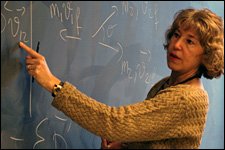Nov. 29, 2011 | WMU News

The online publication PhysOrg.com reported the breakthrough in a recent issue, reviewing published results of work conducted at the Linac Coherent Light Source, at the SLAC National Laboratory at Stanford University in Menlo Park, Calif. The experiments at the Stanford facility are providing a new way to explore atomic structure and dynamics and giving the scientific community more evidence of what the world's most powerful hard X-ray laser can do. The light source has been operational for just over two years.
The article reviewed by PhysOrg.com appeared in an October issue of the Proceedings of the National Academy of Sciences. It represents the first published piece that reveals a favorable comparison with earlier theoretical modeling on how molecules can be differentiated by using free-electron lasers to create a double-core hole by ejecting two electrons from their positions.
Berrah, a WMU professor of physics and a faculty member since 1991, is the lead author on the published results. Working on her team were researchers from Japan's the Institute for Molecular Science and Tohoku and Hiroshima universities, Finland's University of Turku, Sweden's Stockholm and Uppsala universities, the Stanford Linear Accelerator Center, and the Sincrotrone Trieste free-electron laser facility in Italy.
Successful observation of the concept and evidence of how the observed results match the theoretical modeling, Berrah says, will help researchers fingerprint molecules that are similar and lead to a rebirth of electron spectroscopy for chemical analysis--the detection of particles and measurement of their energies. Electron spectroscopy was developed by Swedish physicist Kai Siegbahn, who won a Nobel Prize for his work in 1981.
Berrah and her group are continuing their work using an electronic magnetic bottle that was developed by the Uppsala University researchers to improve their measurements.
Berrah is an atomic physicist and longtime researcher whose work has been regularly funded by the U.S. Department of Energy. She is on sabbatical from the University this year and is in France doing research at the light source facility in Paris called SOLEIL.
For more information, read the full PhysOrg.com review or National Academy of Sciences article.